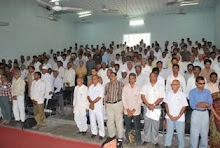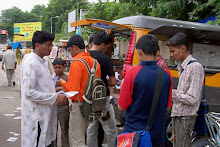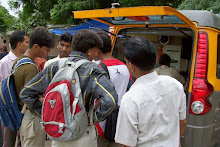Hindustan Times: New Delhi: Wednesday, May 01, 2013.
It could be
the caution that comes with the few highs and frequent lows of single-handedly
taking on, for six years, the country’s oldest Indian Institute of Technology,
but on Tuesday evening IIT Kharagpur computer science professor Rajeev Kumar
wasn’t celebrating the end of a two-year long suspension.
Barely hours
earlier, Kumar, dubbed by the Supreme Court of India as an “unsung hero”
responsible for much of the transparency introduced in the IIT entrance
examination in recent years, had received a brief “memo” from the institute
registrar. It informed Kumar in three typically bureaucratic sentences that the
“competent authority” had decided to allow him “to resume his duty with
immediate effect revoking the suspension” imposed on the 54-year old in 2011.
The
suspension was justified by the IIT as necessary while an enquiry panel it had
set up probed a raft of charges against Kumar. But the nature of the charges
against Kumar -- that included speaking to journalists without permission from
the very authorities he was questioning, based on archaic government rules that
are rarely enforced except when it involves critical news reports – and his
history of tussles with the IIT officials left him convinced he was being
victimized.
“I don’t
think the memo is the end [of the alleged victimization],” Kumar said,
responding cautiously to this correspondent’s call. “All that’s happened is
that instead of sitting at home, I can go sit in office.”
But for the
whistleblower who faced the threat of dismissal from his job till Tuesday, the
IIT Kharagpur order that follows two Delhi high court orders in his favour,
does come as a reprieve, even if only temporary. The reprieve, though, only
highlights the sense of vulnerability that many whistleblowers across India
suffer.
Few among the
lakhs of students across the country preparing for the second leg of the new
two-tiered IIT Joint Entrance Examination (JEE) one June 2 may know his
name, but Kumar was instrumental in
pressuring the IITs to make the test, widely regarded as one of the world’s
toughest entrance barriers, more transparent.
Kumar’s
battle started in 2007, and his story is both a tribute to the Right to
Information (RTI) Act enacted two years earlier, and a cautionary tale for
those keen on using the transparency law.
The computer
science professor was surprised when his son didn’t clear the IIT-JEE in 2006.
Using the RTI Act, he got details of the cut-off marks used by the IITs that
year to select students. Creating an algorithm to test what the IITs did wasn’t
a challenge. Before long, he realized that many students – including his son –
had managed an aggregate score about 100 marks higher than what the IITs said
was their cut-off, but had been disqualified because their chemistry scores
were below the subject cut-off used.
Curious about
the decision to rule out students with an overall performance far superior to
many selected, Kumar pursued with RTI applications, now pressing the IITs for
the formula they used to calculate their cut-offs.
Initially, he
didn’t get any reply. Then, once he approached the courts, the IITs came up
with three different formulae – one in a reply to Kumar, and two others in
affidavits to the courts. None of these formulae yielded the cut-offs the IITs
used. When Kumar exposed this gap, the IITs eventually came up with a fourth
formula that uses multiple iterations to reach the cut-offs.
It is
unlikely to ever be completely clear whether the IITs merely messed up their
reply to Kumar and the first two affidavits, or whether the final formula was
an afterthought.
But what
followed was unprecedented. After Kumar petitioned everyone from the President
and the human resource development (HRD) minister to the chairmen, directors
and faculty of the IITs, with blueprints to make the IIT-JEE more transparent,
the IITs did relent.
Till 2007,
those students who qualified in the IIT-JEE only knew their rank, and no one
knew what they had scored in the test. Students had to return their question
papers to invigilators at the end of the exam, leaving them with no
authoritative way of crosschecking their performance outside the test centre.
The IITs never put out the correct answers to the questions posed in the test.
Today, all
students are told their aggregate and subject-specific scores, and the IITs
place both question papers and the correct answers online after the test is
over, allowing students to verify how they’ve performed. This transparency has
left the IITs exposed to criticism when the test papers contain incorrect
questions or answers, but it has lifted the blanket of opacity that shrouded
the test till Kumar pestered the IITs with his RTI requests.
While
dismissing a petition by Kumar seeking his son’s admission, the Delhi High
Court praised the professor in October 2011 for pressuring the IITs into
injecting transparency into the IIT-JEE. “The appellant will have to be
satisfied with being one of the many unsung heroes who helped in improving the
system,” the court said.
Transparency
in the IIT-JEE wasn’t the only mission Kumar took up.
Starting with
IIT Kharagpur in 1951, India set up the IITs as the country’s premier
engineering schools, modelled on the Massachusetts Institute of Technology. The
institutes remain the country’s best engineering institutions and boast formidable
faculty, top students and alumni who are leading policy makers and CEOs across
the world. But in recent years, the IITs have faced repeated controversies. The
concerns over the 2006 IIT-JEE were only the start.
In 2010, the
Hindustan Times first exposed how senior IIT Kharagpur officials and faculty
members were running an unrecognized, fake institute from within the IIT
campus, duping innocent students by offering them certificates with absolutely
no value. The CBI arrested an aerospace engineering professor believed to be
the mastermind of the racket, and is still investigating the case.
Also that
year, Kumar obtained details – through the RTI Act – of a till-then
unacknowledged, secret quota for children of faculty that the IITs ran for several
years. Kumar also claimed that IIT Kharagpur was pressuring teachers to buy
computers at inflated prices, and that it was doing little to curb cheating in
internal exams.
But Kumar’s
crusade had consequences.
IIT Kharagpur
accused Kumar of trying to manipulate the institute’s procurement policies to
buy a laptop using official funds for personal use. Kumar, the institute said,
had threatened an official – his email had said that he would have to resort to
using the RTI Act if the official failed to act on his demand. The IIT said
there was no evidence to back Kumar’s claims of large-scale cheating in
internal examinations.
And it traced
Kumar’s call records – illegally, without a warrant – to show that he had spoken
to journalists, including this correspondent. The IIT set up an enquiry against
Kumar, and then suspended him pending the result of the probe.
Six months
passed, then a year. But the probe panel – which Kumar accused of bias --
didn’t come out with a report. Meanwhile, Kumar questioned the legality of
keeping him under suspension, citing rules that suggest that such suspensions
must be reviewed every six months.
The IIT
insisted that the rules Kumar was citing didn’t apply to them, but the HRD ministry
ruled that they did. Eventually, the ministry asked the IIT to lift the
suspension against Kumar.
Many within
the academic community have supported Kumar over these years, though few have
come out openly. Equally, several teachers, including Kumar’s colleagues at IIT
Kharagpur, and many administrators have called the computer scientist a
habitual trouble monger, accusing him of hurting the IIT brand name.
Now that the
suspension has been lifted, both Kumar’s silent supporters and his critics will
be watching him again, one question on their minds. The academic in him is
alive again. But is the whistleblower in him still breathing?














































































